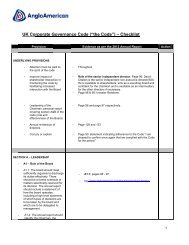Creating Value with the Future in Mind - Anglo American South Africa
Creating Value with the Future in Mind - Anglo American South Africa
Creating Value with the Future in Mind - Anglo American South Africa
Create successful ePaper yourself
Turn your PDF publications into a flip-book with our unique Google optimized e-Paper software.
manag<strong>in</strong>g our impact on <strong>the</strong> environment Land Stewardship and Biodiversity<br />
land stewardship<br />
and biodiversity<br />
<strong>the</strong> Issue<br />
We own large areas<br />
of land throughout<br />
<strong>the</strong> world, <strong>with</strong><br />
some operations<br />
<strong>in</strong> environmentally<br />
sensitive areas.<br />
Ensur<strong>in</strong>g responsible<br />
land stewardship<br />
through all <strong>the</strong> life cycle<br />
stages of an operation<br />
can <strong>in</strong>fluence our future<br />
access to land and<br />
capital, our legal and<br />
social licence to<br />
operate, and reduce<br />
operational risks and<br />
m<strong>in</strong>e closure liabilities.<br />
Land under<br />
<strong>Anglo</strong> <strong>American</strong>’s<br />
management control<br />
511,632 ha<br />
Disturbed land<br />
rehabilitated, to date<br />
17,903 ha<br />
Our strategy and<br />
management approach<br />
Our approach to land stewardship<br />
is governed by various mandatory<br />
<strong>Anglo</strong> <strong>American</strong> Environment Way<br />
performance requirements related<br />
to rehabilitation and <strong>the</strong> management<br />
of water, biodiversity, m<strong>in</strong>eral waste<br />
and hazardous substances, which<br />
apply throughout <strong>the</strong> m<strong>in</strong><strong>in</strong>g life<br />
cycle. These environmental standards<br />
are underp<strong>in</strong>ned by rigorous predevelopment<br />
social and environmental<br />
impact assessments to ensure that<br />
we proactively consider social and<br />
environmental matters <strong>in</strong> our<br />
plann<strong>in</strong>g. Our m<strong>in</strong>e-closure<br />
performance requirements and<br />
toolbox offer specific guidance<br />
on m<strong>in</strong>e closure plann<strong>in</strong>g.<br />
Two core components of land<br />
management we focus on are<br />
rehabilitation (a key regulatory<br />
and f<strong>in</strong>ancial risk for us), and <strong>the</strong><br />
conservation of biodiversity (<strong>the</strong><br />
variety of plant and animal life on<br />
earth which provides a range of<br />
vital benefits, collectively known<br />
as ecosystem services). To help us<br />
maximise <strong>the</strong> value of land hold<strong>in</strong>gs<br />
and m<strong>in</strong>imise impacts, we are<br />
develop<strong>in</strong>g new land management<br />
and biodiversity strategies that take<br />
an ecosystem-services-based<br />
approach to risk management.<br />
Operational excellence<br />
Our Environment Way rehabilitation<br />
performance standard follows <strong>the</strong><br />
mitigation hierarchy approach of<br />
‘avoid, m<strong>in</strong>imise and mitigate’ impacts,<br />
and advocates early and thorough<br />
rehabilitation plann<strong>in</strong>g.<br />
The earlier we commence<br />
rehabilitation, <strong>the</strong> better <strong>the</strong> result.<br />
Rehabilitation that takes place while<br />
<strong>the</strong> m<strong>in</strong>e is operational reduces<br />
operational environmental risks<br />
(such as soil erosion and water<br />
pollution), improves <strong>the</strong> outcomes<br />
of our rehabilitation efforts and is less<br />
costly <strong>in</strong> <strong>the</strong> long run. Rehabilitation<br />
outcomes are developed <strong>with</strong><br />
stakeholders dur<strong>in</strong>g <strong>the</strong> environmental<br />
impact assessment (EIA) process,<br />
and commitments are made to return<br />
land to a specified land capability<br />
A cornerstone<br />
of our work on<br />
biodiversity is<br />
partnerships<br />
and engagement<br />
<strong>with</strong> local<br />
communities,<br />
NGOs and<br />
academic<br />
<strong>in</strong>stitutions.<br />
potential and post-m<strong>in</strong><strong>in</strong>g use. While<br />
stakeholders may agree an alternative<br />
land use dur<strong>in</strong>g <strong>the</strong> course of <strong>the</strong> life<br />
of a m<strong>in</strong>e, it is imperative that such<br />
decisions do not alter <strong>the</strong> rehabilitation<br />
commitments <strong>in</strong> respect of land<br />
capability, <strong>in</strong> order to keep <strong>the</strong><br />
post-m<strong>in</strong><strong>in</strong>g land-use opportunities<br />
as broad as possible.<br />
Given <strong>the</strong> potential of m<strong>in</strong><strong>in</strong>g activities<br />
to disturb habitats through land<br />
disturbance, land-use change<br />
and pollution, basic biodiversity<br />
management is a requirement<br />
<strong>with</strong><strong>in</strong> all our operational ISO 14001<br />
management systems. Where our<br />
EIAs identify significant biodiversity<br />
risks or opportunities, operations<br />
develop stand-alone biodiversity<br />
action plans (BAPs), which seek to<br />
balance ecological considerations<br />
and community needs.<br />
We have proactively sought to ga<strong>in</strong><br />
an even better understand<strong>in</strong>g of our<br />
biodiversity risks and opportunities<br />
so that <strong>the</strong>se are managed <strong>in</strong> <strong>the</strong> same<br />
<strong>in</strong>tegrated and rigorous manner as<br />
o<strong>the</strong>r bus<strong>in</strong>ess risks. Our preference<br />
is to take a risk-based approach,<br />
focus<strong>in</strong>g on <strong>the</strong> potential impacts on<br />
ecosystem services and relat<strong>in</strong>g this to<br />
biodiversity. The supply of fresh water,<br />
for example, is a critical ecosystem<br />
service on which our communities and<br />
operations rely. Through effective<br />
management of biodiversity we can<br />
improve water security.<br />
The requirements of our new<br />
Group-wide <strong>in</strong>tegrated risk<br />
management standard have now been<br />
<strong>in</strong>tegrated <strong>in</strong>to our current biodiversity<br />
performance requirements. The<br />
updated standard was piloted at<br />
Los Bronces m<strong>in</strong>e <strong>in</strong> Chile dur<strong>in</strong>g<br />
2012. This helped <strong>the</strong> m<strong>in</strong>e to more<br />
clearly relate biodiversity issues to its<br />
day-to-day operations and some new<br />
risks were identified.<br />
Our biodiversity partner NGO,<br />
Fauna & Flora International (FFI),<br />
has also helped us to develop a<br />
consistent methodology for<br />
conduct<strong>in</strong>g high-level biodiversity<br />
risk assessments, which articulate<br />
<strong>the</strong> bus<strong>in</strong>ess case for biodiversity<br />
management.<br />
64 <strong>Anglo</strong> <strong>American</strong> plc Susta<strong>in</strong>able Development Report 2012



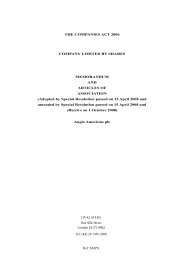
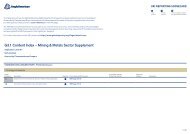
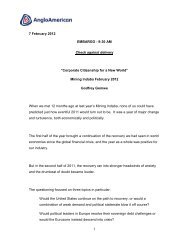
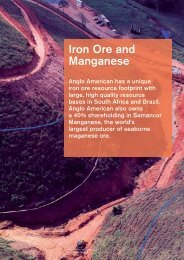
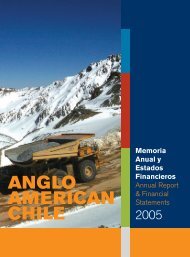
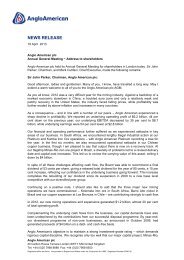
![English PDF [ 189KB ] - Anglo American](https://img.yumpu.com/50470814/1/184x260/english-pdf-189kb-anglo-american.jpg?quality=85)
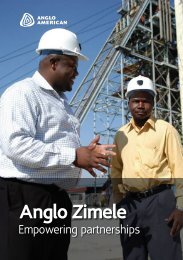

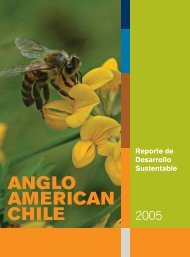

![pdf [ 595KB ] - Anglo American](https://img.yumpu.com/49420483/1/184x260/pdf-595kb-anglo-american.jpg?quality=85)
![pdf [ 1.1MB ] - Anglo American](https://img.yumpu.com/49057963/1/190x240/pdf-11mb-anglo-american.jpg?quality=85)
